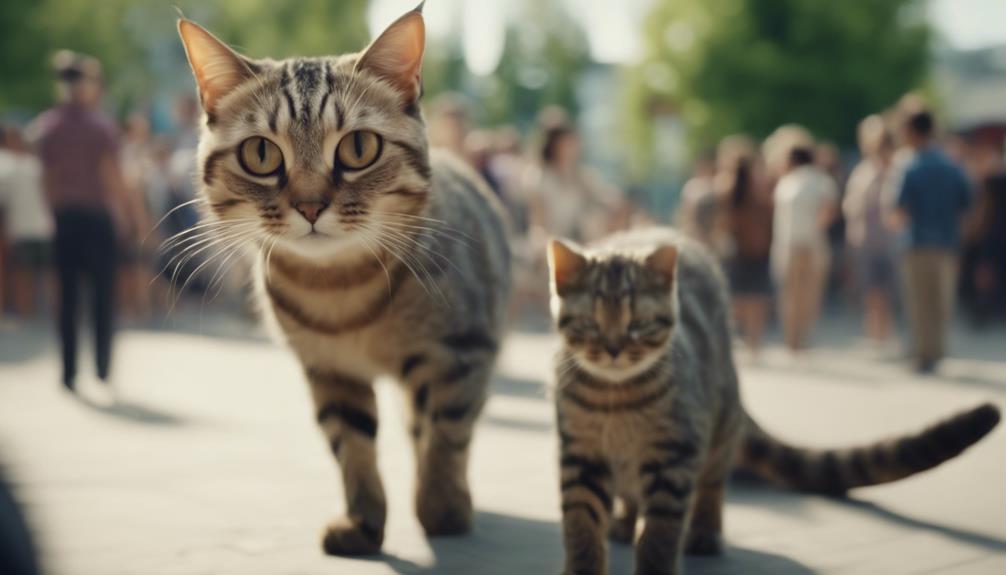How to Gauge Your Cat's Readiness for Socialization

Understanding your cat's comfort level is crucial when gauging their readiness for socialization. Start by observing their body language and behavior. Signs of fear and anxiety include hiding, hissing, or swatting. To help your cat overcome these feelings, create a safe and calm environment. Gradually introduce them to new people or animals, using positive reinforcement to reward good behavior. Patience is key when socializing a cat, as it can take time for them to feel comfortable. Remember to respect your cat's boundaries and never force interaction. By following these tips, you can help your cat become more social and confident.
Understanding your cat's comfort level is crucial when gauging their readiness for socialization. Start by observing their body language and behavior. Signs of fear and anxiety include hiding, hissing, or swatting. To help your cat overcome these feelings, create a safe and calm environment. Gradually introduce them to new people or animals, using positive reinforcement to reward good behavior. Patience is key when socializing a cat, as it can take time for them to feel comfortable. Remember to respect your cat's boundaries and never force interaction. By following these tips, you can help your cat become more social and confident.
Understanding Your Cat's Behavior
When observing your cat's behavior, it's crucial to pay attention to their body language and vocalizations to understand their socialization readiness. Behavior patterns play a significant role in deciphering your cat's mood and whether they're open to socialization. Understanding cues in cat behavior is essential for creating a positive socialization experience for your feline companion.
Cats exhibit various behavior patterns that can indicate their readiness for socialization. For example, a cat that approaches new people or animals with curiosity and a relaxed body posture is likely more open to social interactions. On the other hand, a cat that exhibits signs of fear or aggression, such as hissing, growling, or hiding, may not be ready for socialization and requires a more gradual approach.
Signs of Comfort and Confidence

Cats often communicate their comfort and confidence levels through subtle body language cues that can be observed by attentive pet owners. Understanding how your cat interacts with humans, whether it's seeking affection, initiating play, or showing signs of trust, provides valuable insights into their socialization readiness.
Body Language Cues
To gauge your cat's socialization readiness, observe its body language cues that indicate comfort and confidence. Understanding your cat's vocalization patterns and facial expressions can offer insights into its socialization progress and readiness indicators. Cats display a range of behaviors that can signal their comfort and confidence levels. Here are some common body language cues to look out for:
| Comfortable Cues | Confident Cues |
|---|---|
| Relaxed body posture | Direct eye contact |
| Slow blinking | Tail held high |
| Kneading paws | Ears forward |
| Purring contentedly | Playfulness |
Interactions With Humans
Interacting with humans, cats demonstrate comfort and confidence through subtle cues in their behavior and body language. Playful engagement is a positive sign that a cat is building trust with humans. Cats may exhibit this by initiating play, such as chasing after toys or eagerly participating in interactive games.
Tail held high, relaxed body posture, and purring are all indicators of a cat feeling at ease and secure in human interactions. Building trust with a cat involves being patient, providing positive reinforcement, and respecting their boundaries.
Over time, as trust deepens, cats are more likely to seek out human companionship, show affection, and engage in interactive play willingly. Understanding and responding to these cues can help strengthen the bond between cats and their human caregivers.
Body Language Cues to Watch

Cats communicate through subtle body language cues that can reveal their socialization readiness. Tail position signals, eye contact behaviors, and ear movement indications are key elements to observe when gauging a cat's comfort level.
Understanding these cues can help pet owners build trust and strengthen their bond with their feline companions.
Tail Position Signals
Observing a cat's tail position can provide valuable insights into their current emotional state and intentions. Tail language interpretation is a key aspect of feline communication.
When assessing a cat's socialization readiness, paying attention to the tail position is crucial. A tail held high indicates a confident and content cat, likely open to social interactions.
On the other hand, a low or tucked tail suggests fear or discomfort, signaling that the cat may not be ready for socialization. A tail that's puffed up can indicate agitation or aggression, highlighting the need to approach with caution.
Eye Contact Behaviors
When evaluating a cat's socialization readiness, understanding their eye contact behaviors provides essential insights into their comfort level and receptiveness to interaction. Cats use eye contact to communicate their feelings and intentions. A cat that maintains soft, slow blinks or dilated eyes while looking at you is likely building trust and feeling relaxed.
On the other hand, direct, unwavering stares may indicate the cat is establishing boundaries or feeling threatened. It's vital to respect these cues and not force interaction when a cat avoids eye contact or displays signs of discomfort. By observing their eye contact behaviors, you can better understand your cat's emotional state and tailor your approach to gradually foster positive socialization experiences.
Ear Movement Indications
Ear movements in cats serve as crucial body language cues that can provide valuable insights into their current emotional state and communication intentions. When observing your cat's ears, here are some key indications to consider:
- Tail flicking, ear twitching: These rapid movements can signal agitation or annoyance.
- Eye dilation, whisker movement: Dilated eyes and active whiskers may suggest alertness or curiosity.
- Ears forward: Forward-pointing ears often indicate a cat's interest in its surroundings or a positive interaction.
- Ears flattened: Flattened ears typically signify fear, aggression, or discomfort.
Understanding these ear movements can help you better interpret your cat's feelings and tailor your socialization efforts accordingly.
Gradual Exposure Techniques

To acclimate your cat to new environments, introduce them gradually with controlled exposure sessions. Slow introduction is key to helping your cat feel comfortable and safe in unfamiliar situations. Begin by creating a calm and quiet space where your cat can explore at their own pace. Use a step-by-step approach, starting with short sessions and gradually increasing the time spent in the new environment. Monitor your cat's body language for signs of stress or fear, and be ready to adjust the exposure accordingly.
During each exposure session, provide familiar objects like their favorite toys or bedding to help create a sense of security. Offer treats and verbal praise to encourage positive associations with the new environment. If your cat shows signs of distress, such as hiding or excessive vocalization, reduce the exposure time and provide a quiet place for them to retreat to.
Importance of Positive Reinforcement

Utilizing positive reinforcement techniques is essential for encouraging desirable behaviors in your cat and strengthening the bond between you and your feline companion. When it comes to behavior modification and reinforcement training, positive reinforcement stands out as a powerful tool in shaping your cat's actions and responses.
Here are four key reasons why positive reinforcement is crucial in cat socialization:
- Encourages Good Behavior: Positive reinforcement rewards your cat for displaying desired behaviors, making it more likely for them to repeat those actions.
- Strengthens the Human-Animal Bond: By associating positive experiences with your presence, your cat learns to trust and enjoy interacting with you.
- Reduces Stress and Anxiety: Creating a positive environment through rewards helps alleviate fear and anxiety in your cat, promoting a sense of security.
- Enhances Learning: Cats respond well to positive reinforcement, making it an effective method for teaching them new skills and behaviors.
Handling Fear and Anxiety

Handling fear and anxiety in cats requires a structured approach that focuses on gradual exposure and positive reinforcement techniques to build their confidence and sense of security. Building trust is crucial in helping cats overcome their fears. Start by creating a safe space where the cat feels secure, providing hiding spots, and allowing them to approach at their own pace. Calming techniques such as gentle petting, soft music, or pheromone diffusers can help soothe anxious cats.
Consistency is key in managing fear and anxiety. Establish a routine to create predictability for the cat, which can reduce stress levels. Rewarding brave behavior with treats or playtime reinforces positive associations. Slowly introduce new experiences, people, or environments in a controlled manner to prevent overwhelming the cat.
It's essential to observe the cat's body language for signs of stress and adjust the approach accordingly. Patience and understanding are vital in helping cats feel more comfortable and secure in their environment, ultimately aiding in their socialization process.
Seeking Professional Guidance

When facing challenges in handling fear and anxiety in cats, seeking professional guidance can provide valuable support and expertise in addressing your cat's specific needs. Professional support is crucial in aiding behavior modification and ensuring a safe and effective socialization process for your feline companion. Here are four key reasons why seeking professional guidance is essential:
- Specialized Knowledge: Professional behaviorists and veterinarians have specialized training and experience in understanding cat behavior and can provide tailored solutions.
- Customized Plans: These experts can create individualized behavior modification plans to address your cat's specific fears and anxieties.
- Safe Environment: Professionals can guide you on creating a safe environment for your cat to facilitate socialization without causing undue stress.
- Long-Term Success: With professional support, you can work towards long-term success in helping your cat overcome fear and anxiety, leading to a happier and more socialized pet.
Frequently Asked Questions
Are There Any Specific Socialization Techniques That Work Best for Shy or Anxious Cats?
When working with shy or anxious cats, behavior modification techniques emphasizing patience and consistency are key. By using gentle training methods and creating a calm environment, owners can help their feline friends build confidence and overcome socialization challenges.
How Can I Tell if My Cat Is Ready to Be Introduced to Other Animals in the Household?
To gauge a cat's readiness to be introduced to other animals in the household, observe their body language and signs of comfort or stress. Positive behavior and interactions, like curiosity and calmness, indicate a higher likelihood of successful socialization.
What Should I Do if My Cat Shows Signs of Aggression During Socialization Attempts?
If a cat displays aggression during socialization, addressing it with positive reinforcement is key. Consistent training, patience, and creating a safe environment can help modify behavior. Seeking guidance from a veterinarian or animal behaviorist is advisable for complex cases.
Can Socialization Techniques Be Used to Help a Cat Overcome Past Trauma or Abuse?
To rehabilitate a cat from past trauma or abuse, trust-building techniques are essential. Patience and consistency are key in this delicate process. Socialization can aid in overcoming fears and building a stronger bond with the cat.
How Long Does It Typically Take for a Cat to Become Fully Socialized to New People and Environments?
Cats vary in socialization progress; timelines can differ. Behavioral cues and readiness indicators play key roles. Patience is crucial. Each cat adapts at its own pace. Understanding individual needs fosters successful socialization.











